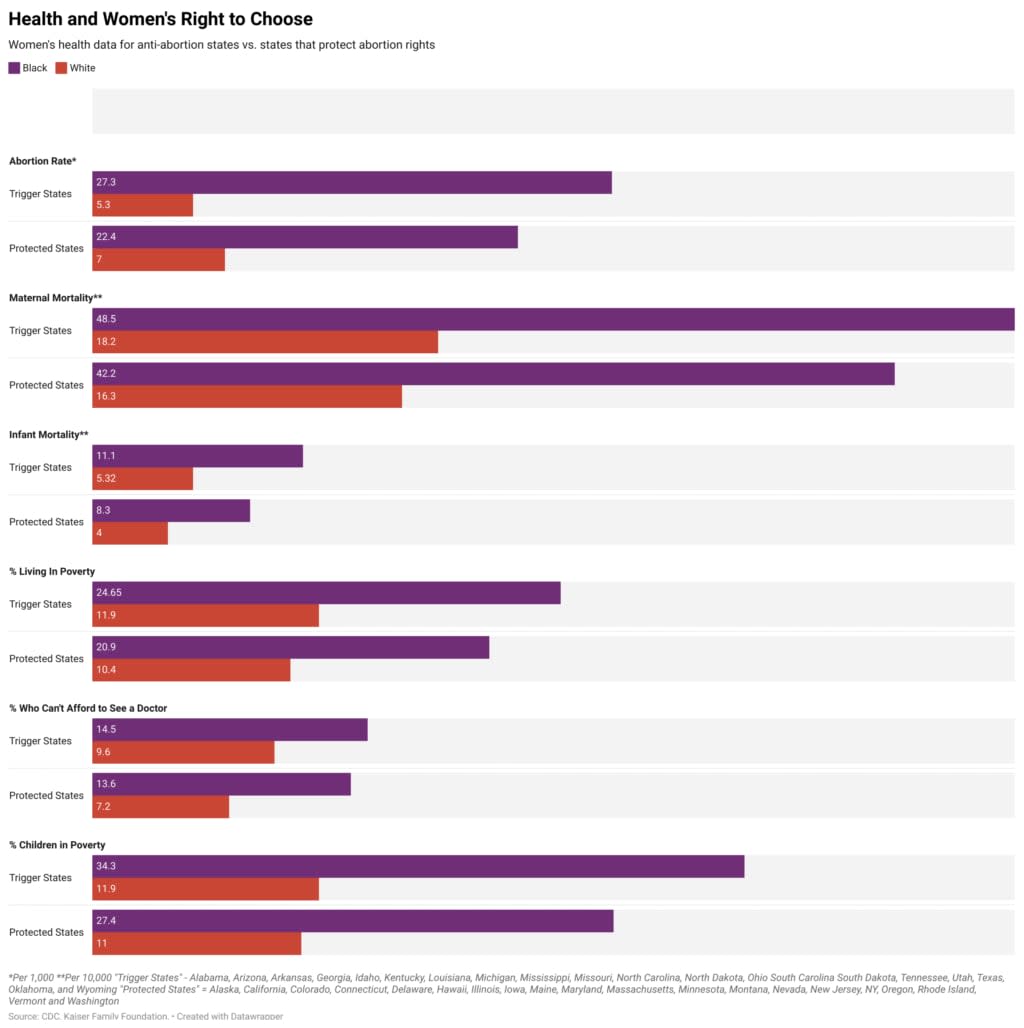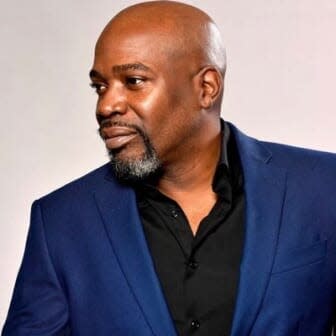Why ‘pro-life’ doesn’t apply to Black women, explained
OPINION: Data shows that anti-abortion legislation negatively affects Black women and children. The moment the Supreme Court overturns Roe v. Wade, it’s going to get worse.
Editor’s note: The following article is an op-ed, and the views expressed are the author’s own. Read more opinions on theGrio.
There is no such thing as a “pro-life” movement.
If the reports that the U.S. Supreme Court is set to overturn Roe v. Wade are true, the conservative evangelical movement that emerged when Regan-era segregationists radicalized a segment of evangelical Christians has already condemned millions of children and women to death. While anti-abortion policies negatively affect women, children and families of all races and ethnicities, Black women and children suffer the most harm from this American-style fundamentalist tyranny. In fact, when theGrio looked at the data, one thing became abundantly clear:
“Pro-life” is anti-Black.
Here are the unvarnished facts:
What are trigger laws?
Simply put, a trigger law is a piece of legislation that has been passed but has been rendered unenforceable by a variety of circumstances. If the barrier that invalidates the law is removed, the law immediately becomes enforceable.
For instance, as late as 2004, many states still had segregation laws on the books. Alabama’s constitution outlawed interracial marriage until 2021. If, for some reason, the Supreme Court overturned the precedent set by Brown v. Board of Education or Loving v. Virginia, states with trigger laws could immediately enforce those Jim Crow-era laws without passing any additional legislation.
As it relates to abortion, the Roe v. Wade decision invalidated individual state laws that restricted abortion. These laws would immediately go into effect once the Supreme Court overturns the 49-year-old decision that constitutionally guaranteed women autonomy over their bodies. Other states intentionally passed draconian laws after Roe v. Wade with the hopes that the decision would one day be overturned.
Think of “trigger laws” like a white woman’s tears. As soon as an Ashleigh removes the barrier that prevents her eyes from making water, Black people are in trouble.
Which states have trigger laws?
There are 13 states (Arkansas, Idaho, Kentucky, Louisiana, Mississippi, Missouri, North Dakota, South Dakota, Tennessee, Utah, Texas, Oklahoma and Wyoming) with so-called “trigger laws” banning abortion. According to the Center for Reproductive Rights and legislation we examined, another seven states (Alabama, Arizona, Georgia, Michigan, North Carolina, Ohio and South Carolina) have pre-existing laws that predate Roe v. Wade or have since passed legislation that would immediately become valid. (We didn’t use data for the U.S. territories Guam, North Mariana Islands or American Somoa, where abortion would also be banned.)
If a woman doesn’t live in one of these states, are her rights protected?
Not quite.
Only 20 states (Alaska, California, Colorado, Connecticut, Delaware, Hawaii, Illinois, Iowa, Maine, Maryland, Massachusetts, Minnesota, Montana, Nevada, New Jersey, New York, Oregon, Rhode Island, Vermont and Washington) and the District of Columbia have legislation on the books that protect a woman’s right to choose. Legislators in the remaining states are free to either ban abortion, protect women’s rights or do nothing at all. A politician in a conservative-leaning state could coalesce a pro-choice constituency by campaigning to ban abortion…
Theoretically.
To be fair, it’s highly unlikely that a politician could succeed by promising to strip people of their rights. This is America, so it’s highly unlikely that the patriots in an unprotected, almost-red state like Florida would stand for their legislators stripping people of freedoms they already enjoy.
That’s just crazy.
But if Roe v. Wade is the law of the land, how can you predict that women would be worse off in states that would ban abortions?
Facts.
It is an undeniable fact that women and children in the states that would ban abortion already have worse health outcomes. The health outcomes are even worse for Black women and children. Black women who live in trigger states are more likely to live in poverty, are more likely to die from pregnancy complications and are less likely to be able to afford health care. Black infants born in these states are more likely to die before their first birthday and are more likely to live in poverty. Furthermore, Black women and children who live in protected states are less likely to suffer from these health care disparities.
How do you know this?
TheGrio collected 2019 state-level data (the most current year that was available in each category) from the Centers for Disease Control and Prevention, the Census Bureau and individual state health agencies to create a statistical comparison of the differences in women’s and children’s health status.
We compared the statistical data for the 20 trigger states (states that would effectively ban abortion once Roe is overturned), 20 protected states (states where a woman’s right to choose is protected) and the national average in seven statistical categories:
Population: Of course, demographic variations account for some of these disparities (Nine of the 16 states where the Black population is higher than the national average are trigger states). So, we used the Census Bureau’s numbers to adjust the data for a fair comparison.
Abortions: We used both the total number and the rate of abortions by race from the CDC’s abortion surveillance research.
Maternal mortality: According to the CDC and the National Vital Statistics Reports, this “does not include all deaths occurring to pregnant or recently pregnant women” but only those deaths with pregnancy as the underlying cause.
Infant mortality: We used the CDC database.
Women who can’t afford health care: The actual statistic is “Women who report not seeing a doctor in the past 12 months due to cost.”
Women living in poverty: The percentage of nonelderly adult women living below the official poverty threshold.
Children living in poverty: The share of children under age 18 who live in families with incomes below the federal poverty level, as defined by the U.S. Office of Management and Budget.
Basically, theGrio decided to eff around and find out.
What did you find out?
Let’s get this out of the way: In 2019, Black women were five times more likely to have an abortion than white women.
Purportedly “pro-life” people love using that statistic.
However, this statistic reflects that Black women are two-and-a-half times more likely to die because of pregnancy complications. Black women are more likely to live in poverty and more likely to not have a primary care physician or be able to afford a doctor. Black children are twice as likely to die before their first birthday and three times as likely to live in poverty.
But in trigger states, the disparities are even worse:
Most of the Black children who die before their first birthday live in states where abortion would be banned.
The abortion rate for white women is lower in trigger states, while the rate of Black abortion is higher.
A Black woman in a trigger state is 15 percent more likely to live in poverty.
In every statistical category, Black women who live in states where abortion rights are protected have better health outcomes. The same is not true for white women.
In states where abortion would be banned, every statistical health outcome for Black women is worse than the national average.

How does this contradict the “pro-life” movement?
Well, it’s impossible to stop all abortions. The “pro-life” movement can only make them more expensive, less safe and harder to obtain.
However, anyone who was actually concerned about protecting the lives of children or believed that life begins at conception could save millions of lives by focusing on the 3 million Black women who can’t afford to see a doctor, the 5 million Black women living in poverty or the 3.2 million Black children living in poverty. But instead of focusing on health care disparities, poverty and the structural problems that actually threaten the lives of Black women and children, they have chosen to put more Black women and children at risk by robbing them of their choice.
Statistically, speaking, the “pro-life” movement doesn’t make any logical sense.
Unless, of course, they don’t believe that a Black life actually matters.
Good point.

Michael Harriot is a writer, cultural critic and championship-level Spades player. His book, Black AF History: The Unwhitewashed Story of America, will be released in 2022.
TheGrio is FREE on your TV via Apple TV, Amazon Fire, Roku, and Android TV. Please download theGrio mobile apps today!
The post Why ‘pro-life’ doesn’t apply to Black women, explained appeared first on TheGrio.
